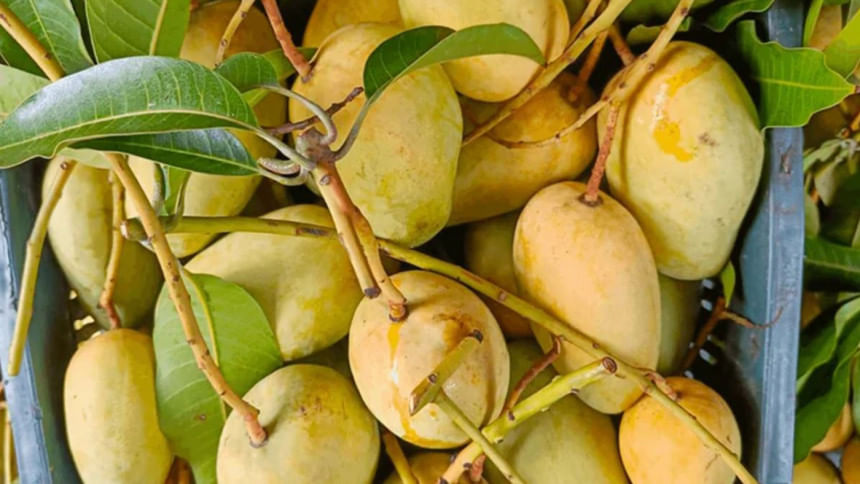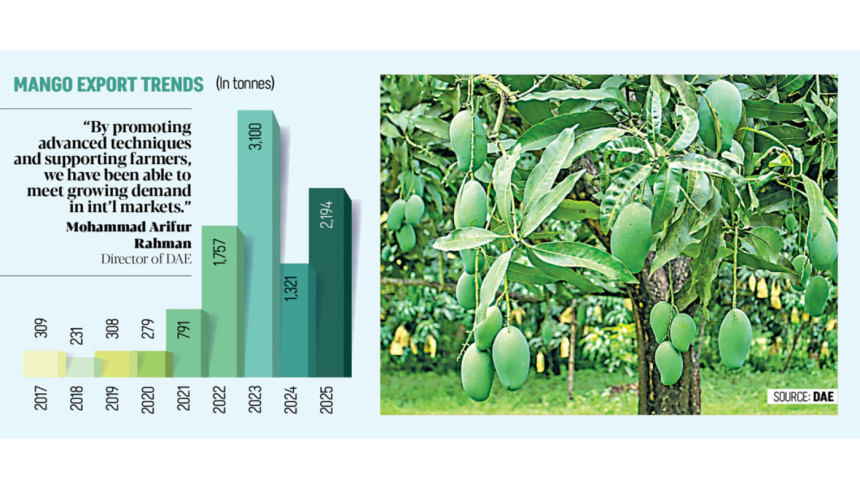Mango exports rebound as quality, production improve

Bangladesh has seen a rise in mango exports this year following a slump in the past season. With the current export season drawing to a close this month, shipments have reached 2,194 tonnes, up 66 percent on last year.
Agri officials say the fruit's quality has improved, and a larger share of the crop has met export standards, increasing overseas sales.
Mango export from the country began nearly a decade ago, initially catering mainly to Bangladeshi communities in the UK, Italy and the Middle East. The market has since somewhat expanded, especially after China expressed interest in sourcing more mangoes from Bangladesh a few years ago.
The country produces 2.4-2.5 million tonnes of mangoes annually for a domestic market worth Tk 13,000-14,000 crore. Commercial cultivation now covers 23 districts, with 72 varieties grown nationwide. Exporting, which starts in late May and runs until late September, began in 2015.
Mexico, India, Brazil, the Netherlands and Peru are consistently cited as leading mango exporters. Bangladesh also produces the fruit in abundance, and industry insiders believe exports could rise to 8,000 tonnes with government support.
But farmers and exporters point to weak infrastructure and certification issues as key obstacles.

According to the Department of Agricultural Extension (DAE), Bangladesh exported 1,321 tonnes of mangoes in 2024, and 3,100 tonnes in 2023.
"Improving both the quality and quantity of mango production has significantly contributed to this year's rebound," said Mohammad Arifur Rahman, director of the DAE exportable mango production project.
Of the total 72 varieties, only seven or eight varieties go abroad, with Amrapali alone accounting for about 80 percent of shipments. Other exportable varieties include Himsagar, Langra, BARI-4 and Fajli.
Rahman said, "By promoting advanced techniques and supporting farmers with resources, we have been able to meet growing demand in international markets."
He, however, admitted the export challenges, especially high air freight charges that limit the country's ability to realise its full potential.
Mohammad Mansur, general secretary of the Bangladesh Fruits, Vegetables and Allied Products Exporters Association, said freight costs rose two to three times last year compared with normal rates, causing exports to fall.
He said Bangladesh's fruit and vegetable export sector, including mangoes, has significant potential but faces obstacles that need urgent attention. "High freight costs and inadequate infrastructure, such as the absence of vapour heat treatment facilities, limit our ability to compete in key international markets."
Government support in setting up modern processing and treatment plants is crucial to improve both the quality and quantity of exports, he added.
This year, Bangladeshi mangoes reached 26 countries. The UK imported the largest volume at 686 tonnes, followed by Saudi Arabia with more than 356 tonnes, Italy with over 264 tonnes, Kuwait with over 167 tonnes and Qatar with 163 tonnes. China joined as a new destination with 5 tonnes exported.
Exports to the UK are driven largely by its sizable South Asian community.
"Bangladeshi mangoes may not always look perfect, but their taste is superior; this is why demand is so strong," DAE official Rahman said.
In the Middle East, demand comes from both expatriates and local consumers, with relatively low air freight to Saudi Arabia supporting the trade.
European markets such as Italy show similar demand patterns to those of the UK.
FUTURE MARKETS AND CHALLENGES
The Organisation for Economic Co-operation and Development (OECD) estimated that global fresh mango exports reached around 2.1 to 2.2 million tonnes in 2024, with Bangladesh accounting for just 0.1 percent of the market.
Agri experts say the country still lacks a comprehensive export plan.
"Despite producing 24-25 lakh tonnes of mangoes every year, Bangladesh has not built the infrastructure or policies required to raise exports," said Sorof Uddin, principal scientific officer at the Regional Horticulture Research Station in Chapainawabganj, a key mango-producing district in Bangladesh.
He said current capacity caps mango exports at about 4,000 tonnes, and even with coordinated efforts, it would be difficult to cross the 8,000-tonne mark.
To increase the export, farmers and traders stressed the need for decentralised infrastructure, contract farming and large dedicated exporters.
Agriculture Adviser Lt Gen (Retired) Md Jahangir Alam Chowdhury recently said that although Bangladesh produces mangoes in large quantities, export volumes remain modest compared with potential.
The government, he said, is working to improve quality and expand markets.
China has already begun importing, while Japan and Australia have expressed interest. Officials believe these markets could provide fresh momentum in the coming years.

 For all latest news, follow The Daily Star's Google News channel.
For all latest news, follow The Daily Star's Google News channel. 





Comments